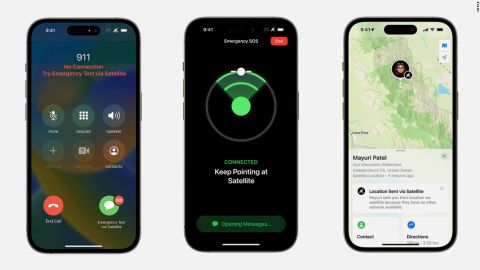We tried Apple’s new SOS tool for when you don’t have cell service
CNN Business
—
When Apple announced at its closely-watched September product launch event that it would soon introduce an Emergency SOS feature powered by a network of satellites orbiting above Earth, Brooklyn probably wasn’t the secluded location most had in mind for using it.
But on a rainy afternoon last week, I found myself trying to stay connected to one of the satellites from Prospect Park as part of a demo of the upcoming feature. I stepped out from under a giant oak tree and the rain started to come down harder. Then I moved my device slightly to the right and quickly regained access to the signal and continued messaging with an emergency dispatcher.
The rain wasn’t the issue; it was the foliage limiting my phone’s view of the sky.
On Tuesday, Apple
(AAPL) will launch the Emergency SOS via Satellite feature for those with an iPhone 14 in the United States and Canada, with plans to roll it out in the UK, France, Germany and Ireland next month. The free feature promises to let iPhone users contact dedicated dispatchers in emergency situations via satellites when a cell phone network is unavailable.
Hikers, emergency responders and intrepid travelers may be well versed in the existing world of satellite phones, which provide voice, SMS, and data services anywhere on Earth. But existing satellite phones often have large protruding antennas. Apple said it wanted to invent a technology that would allow communication directly with satellites still within the form factor of the iPhone.
“It started with us finding frequencies that would work on iPhone that were also available for use on satellites,” Arun Mathias, vice president of wireless technologies and ecosystem at Apple, told CNN Business. “Then we made the necessary hardware modifications on iPhones, but with no bulky antennas.” Apple, he added, first built new software that enabled the iPhone to communicate with the satellites and then designed the user experience around that.
The effort is part of a broader pitch this year to consumers that its devices don’t just help them live better, but also live safer. In the process, it could make its pricey products seem a bit more indispensable in an uncertain economic environment that has some rethinking expenses.
Apple recently invested $450 million in Globalstar, a global satellite service, and other providers to support the development of 24 low-orbit satellites flying 16,000 mph at a higher altitude than the International Space Station. The investment is part of Apple’s Advanced Manufacturing Fund, which has previously been used for glass production with Corning and laser technology for facial recognition.
During my test with an iPhone 14 provided by Apple, I attempted to call 911 but was automatically redirected to Emergency SOS via Satellite dispatchers for the purposes of the demo. When the device was unable to connect to cellular service, a small green icon appeared at the bottom right of the call screen to initiate a text conversation with emergency services.

I was prompted to fill out a questionnaire and tapped through a handful of short multiple choice questions; I noted I was lost but not injured. Apple said because the user may be in a distressed state, a questionnaire helps to gather critical information more quickly. (It’s the same set of questions a 911 dispatcher ask.)
“When we’ve gone out and tested this with dispatchers in the field, they’ve even told us that in some situations the answers they get from the questionnaire, along with the user’s location, could be enough for them to actually make a dispatch decision, right at the beginning, and that’s huge in terms of reducing to get help to get field responders out to the user,” said Trey Forgety, software engineering manager of emergency systems at Apple.
Nearly 20 seconds later, I received confirmation that my geo-location coordinates were sent to a dispatcher, along with my medical ID, emergency contact information and the answers to my questions. I was told to keep responses short, likely to cut down on the amount of data needed to transfer to the satellite and back down to a dispatcher. I was also asked to identify nearby landmarks and where I entered the park. My total exchange lasted about four minutes.
Apple said the size of the texts are reduced down to about a third of their original size, by running it through a compression algorithm. This allows the satellite to more efficiently route messages to ground stations located all over the world. Once received, texts are sent to local emergency services or a relay center with Apple-trained emergency specialists who can send help….
Read More: We tried Apple’s new SOS tool for when you don’t have cell service

